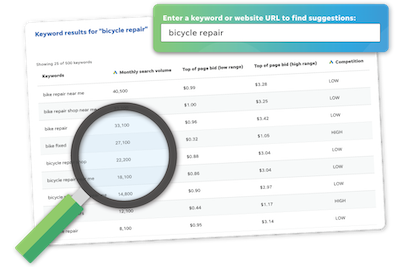Popular Keyword – Shopping Cart Solutions Keywords
Search Popular Keywords in Your Industry
These are the most popular suggestions for Shopping Cart Solutions Keywords generated by WordStream’s Free Keyword Tool. To get have all of these keywords sent to you, simply enter your Email address and click “Email Keywords” below.
Your keywords are on the way to your inbox!
Shopping Cart Solutions Marketing Tips and Tricks
The key thing that’s missing from debates regarding ecommerce and the future of brick-and-mortar stores: rationality. No matter which side someone falls on—either declaring ecommerce unsustainable or pronouncing physical retail dead—he’s likely going to blow it out of proportion. Here are the facts
Ecommerce is growing far more rapidly than physical retail: 25% annually versus 2% annually. Still, physical retail dominates the industry: 90% of retail purchases are made in stores rather than online. Evidently, the meteoric rise of ecommerce and the strength of physical retail aren’t mutually exclusive.
Let’s narrow our focus on ecommerce. It’s booming and shows no signs of slowing down. Businesses of all kinds are looking into selling through their websites and are in need of shopping cart solutions. We’re here to provide our best online advertising advice to marketers of such solutions.
First things first—content marketing. 93% of business-to-business (B2B) marketers use content marketing and those that specifically use blogs drive 67% more leads than those that don’t. The idea behind content marketing is that you can provide free, valuable information—in the form of blog posts, whitepapers, infographics, videos—as means to drive leads to the top of your marketing funnel. Giving prospects sound content casts your business in a favorable light and, if done cleverly, demonstrates the value of your business.
For example, a business that sells shopping cart software can add a blog to their website and use it as a platform to publish news articles related to ecommerce and retail more broadly. Particularly good blog posts may earn editorial links from other websites, each of which signals to Google that the content is high-quality. This is a search engine optimization (SEO) dream, as it’s one of the best ways to improve your performance in the organic search results.
Shifting gears to paid search marketing, it’s crucial for shopping cart solutions marketers to understand keyword intent. Take the top keyword in our list, for example: “ecommerce.” This is known as a broad keyword or a head term—it’s vague and it drives high search volumes. Your business should be weary of bidding on keywords like this because there is no clear commercial intent. This means that you’ll drive a lot of impressions that don’t turn into clicks—people who simply want to learn more about ecommerce aren’t interested in your business. This translates into a low click-through (CTR), which in turn pushes up your cost per click as your ads perform worse and worse in the search results.
Alternatively, your business should conduct some research and find out which long-tail keywords in your industry drive a good amount of traffic. Long-tail keywords drive less search volume than broad keywords, but they signify greater commercial intent, which means your ads will drive more clicks, more conversions, and lower costs per action (CPAs).
Alright—your incorporation of more long-tail keywords has helped drive a lot of relevant clicks. Now, you need to optimize your landing pages to ensure that those clicks turn into conversions. Fun fact: prospects tend to read web pages by scanning in F-shaped and Z-shaped patterns. By organizing your landing pages such that a skimming prospect can clearly find your headline, value proposition, and call to action (CTA), you improve the chances of fully communicating your message and driving a conversion.
For more online advertising wisdom, read the WordStream blog.
BUSINESS KEYWORDS
- Accounting Keywords
- Affiliate Keywords
- Auto Insurance Keywords
- B2B Ecommerce Keywords
- B2B Keywords
- Biotechnology Keywords
- Business Keywords
- Business Management Keywords
- Business Travel Keywords
- Construction Keywords
- Credit Card Keywords
- Debt Keywords
- Entertainment Keywords
- Finance Keywords
- Human Resources Keywords
- Insurance Business Keywords
- Internet Security Keywords
- Management Keywords
- Office Supplies Keywords
- Online Payment Solutions Keywords
- Software Keywords
- Startup Keywords
- Web Hosting Keywords
CONSUMER KEYWORDS
- Art Keywords
- Automotive Keywords
- Casino Keywords
- Cell Phone Keywords
- Computer Keywords
- Dating Keywords
- Ecommerce Keywords
- Electronics Keywords
- Email Keywords
- Fashion Keywords
- Golf Keywords
- Hotel Keywords
- Internet Keywords
- Jobs Keywords
- Law Keywords
- Mortgage Keywords
- Music Keywords
- Online Stores Keywords
- Pest Control Keywords
- Photography Keywords
- Plumbing Keywords
- Real Estate Keywords
- Restaurants Keywords
- Shoes Keywords
- Travel Keywords
- Wedding Keywords
FINANCE KEYWORDS
HEALTH & WELLNESS KEYWORDS
MISCELLANEOUS KEYWORDS
- Aerospace Keywords
- Agriculture Keywords
- Best Travel Keywords
- Coffee Keywords
- Dog Training Keywords
- Education Keywords
- Environmental Keywords
- Food & Beverage Keywords
- Forex Keywords
- Gifts Keywords
- Home Based Business Keywords
- Home Improvements Keywords
- Internet Games Keywords
- iPhone Keywords
- Jewelry Keywords
- Landscaping Keywords
- Legal Keywords
- Luggage Keywords
- Pharmaceutical Keywords
- Poker Keywords
- Retail Keywords
- School Education Keywords
- Solar Energy Keywords
- Transporation Keywords
- Women Fashion Keywords
- Work From Home Keywords

